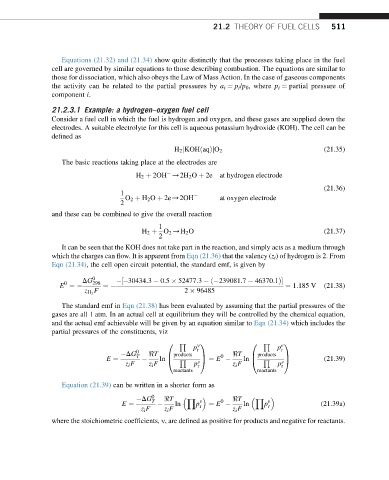Page 518 - Advanced thermodynamics for engineers
P. 518
21.2 THEORY OF FUEL CELLS 511
Equations (21.32) and (21.34) show quite distinctly that the processes taking place in the fuel
cell are governed by similar equations to those describing combustion. The equations are similar to
those for dissociation, which also obeys the Law of Mass Action. In the case of gaseous components
the activity can be related to the partial pressures by a i ¼ p i /p 0 ,where p i ¼ partial pressure of
component i.
21.2.3.1 Example: a hydrogen–oxygen fuel cell
Consider a fuel cell in which the fuel is hydrogen and oxygen, and these gases are supplied down the
electrodes. A suitable electrolyte for this cell is aqueous potassium hydroxide (KOH). The cell can be
defined as
H 2 jKOHðaqÞjO 2 (21.35)
The basic reactions taking place at the electrodes are
H 2 þ 2OH /2H 2 O þ 2e at hydrogen electrode
(21.36)
1
O 2 þ H 2 O þ 2e/2OH at oxygen electrode
2
and these can be combined to give the overall reaction
1
H 2 þ O 2 /H 2 O (21.37)
2
It can be seen that the KOH does not take part in the reaction, and simply acts as a medium through
which the charges can flow. It is apparent from Eqn (21.36) that the valency (z i ) of hydrogen is 2. From
Eqn (21.34), the cell open circuit potential, the standard emf, is given by
DG 0 ½ 30434:3 0:5 52477:3 ð 239081:7 46370:1Þ
0 298
E ¼ ¼ ¼ 1:185 V (21.38)
F 2 96485
z H 2
The standard emf in Eqn (21.38) has been evaluated by assuming that the partial pressures of the
gases are all 1 atm. In an actual cell at equilibrium they will be controlled by the chemical equation,
and the actual emf achievable will be given by an equation similar to Eqn (21.34) which includes the
partial pressures of the constituents, viz
0 Q n 1 0 Q n 1
p r p r
DG 0 T <T B products 0 <T B products
C
E ¼ ln @ Q A ¼ E ln @ Q C (21.39)
z i F z i F p v r z i F p n r A
reactants reactants
Equation (21.39) can be written in a shorter form as
DG 0 T <T Y 0 <T Y
n
n
E ¼ ln p r ¼ E ln p r (21.39a)
z i F z i F z i F
where the stoichiometric coefficients, n, are defined as positive for products and negative for reactants.

